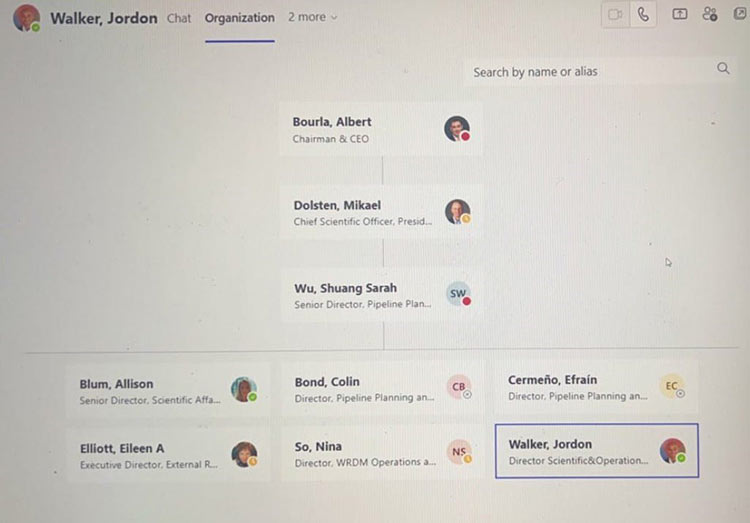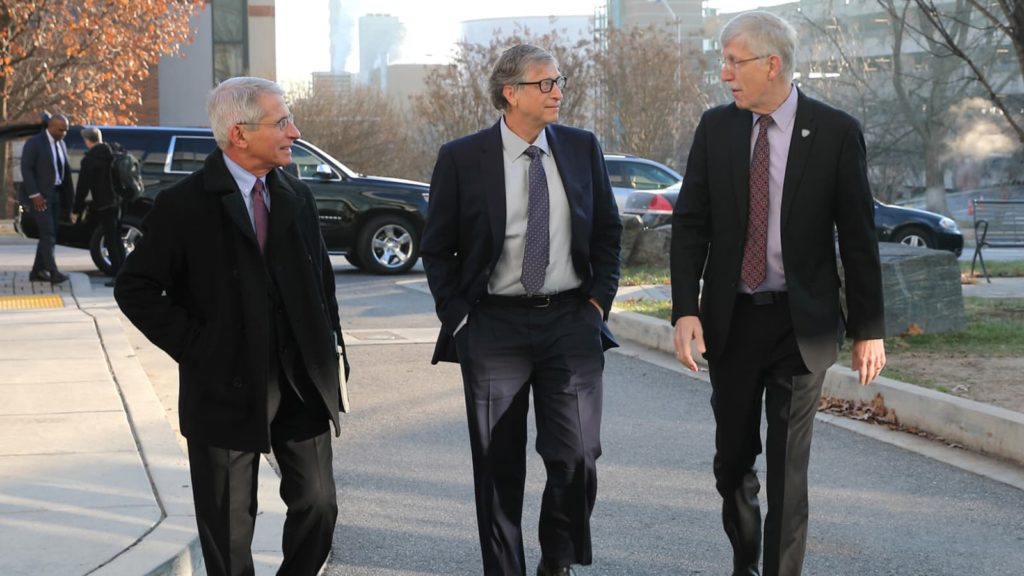The discovery of a contract awarded by the U.S. Department of Defense to Labyrinth Global Health for “COVID-19 Research” in November 2019 has raised questions about the permanent U.S. Government’s knowledge of the novel coronavirus.
The contract was part of a larger project for a “Biological threat reduction program in Ukraine,” suggesting the permanent U.S. Government was at the very least aware of the alleged virus before it spread through Wuhan, China in December 2019.
By on February 7, 2023
But the findings also suggest the permanent U.S. Government may have had a hand in the creation of this alleged virus in Biolabs through Gain of Function Research overseen by Dr Anthony Fauci.
This would explain why they knew the name of the novel coronavirus disease three months prior to the World Health Organization officially naming it Covid-19 in February 2020.
And it may also explain why Moderna and Fauci’s National Institute of Allergy and Infectious Diseases (NIAID) had a confidentiality agreement for an mRNA Coronavirus vaccine candidate in early December 2019, which was developed and jointly owned by Moderna and Fauci’s NIAID.

The U.S. Government’s “USA Spending” website reveals that it had spent a staggering $4.04 trillion “in response to COVID-19”. A deeper look at the website’s “Award Search” feature uncovers a contract awarded by the Department of Defense to Black & Veatch Special Projects Corp. for “Professional, Scientific, and Technical Services” on September 20, 2012.
A closer examination of the contract’s “Sub-Awards” tab reveals 115 transactions with recipients and brief descriptions, the majority of which are mundane items like “laboratory equipment for Kyiv” and “office furniture for Kyiv.”
There is, however, among the 115 transactions listed in the “Sub-Awards” tab of a contract awarded by the U.S. Department of Defense to Black & Veatch Special Projects Corp. one transaction that stands out:
An award to Labyrinth Global Health INC for “SME Manuscript Documentation and COVID-19 Research.”
While it is not surprising to see an award for Covid-19 research during a pandemic, the fact that the contract was awarded on November 12, 2019, at least one month before the alleged emergence of the novel coronavirus and three months before it was officially named Covid-19, raises questions about the government’s knowledge of the virus.
Furthermore, the contract was instructed to take place in Ukraine, as was the entire contract awarded to Black & Veatch Special Projects Corp. These findings suggest potential U.S. Government involvement in the creation and spread of the virus.
In September 2012, the Defense Threat Reduction Agency (DTRA) within the US Department of Defense awarded a contract to a global engineering, procurement, and construction company specializing in infrastructure development.

The contract was for a Biological threat reduction program in Ukraine, and concluded in October 2020. While the details are unclear, it is known that $21.7 million of the $116.6 million contract was spent on this program.
It is puzzling why the DOD would contract a company specializing in infrastructure development for a biological threat reduction program.
Furthermore, it is intriguing that both the DOD and the contracting company subsequently paid Labyrinth Global Health INC to conduct COVID-19 research in Ukraine prior to the emergence of the novel coronavirus and before it was officially named Covid-19.
These events raise questions about the nature of the biological threat reduction program and its potential connection to the alleged COVID-19 pandemic. And the discovery of a contract awarded by the U.S. Department of Defense for Covid-19 research in November 2019 suggests that the U.S Government either knew the virus existed naturally or was involved in constructing it in a lab.
This theory is supported by evidence that the National Institute of Allergy & Infectious Diseases (NIAID) and Moderna had a coronavirus candidate in December 2019.
A confidentiality agreement reveals that NIAID and Moderna agreed to transfer “mRNA coronavirus vaccine candidates” to the University of North Carolina at Chapel Hill on December 12, 2019.
The material transfer agreement was signed the December 12th 2019 by Ralph Baric, PhD, at the University of North Carolina at Chapel Hill, and then signed by Jacqueline Quay, Director of Licensing and Innovation Support at the University of North Carolina on December 16th 2019.
The agreement was also signed by two representatives of the NIAID, one of whom was Amy F. Petrik PhD, a technology transfer specialist who signed the agreement on December 12th 2019 at 8:05 am. The other signatory was Barney Graham MD PhD, an investigator for the NIAID, however, this signature was not dated.
The final signatories on the agreement were Sunny Himansu, Moderna’s Investigator, and Shaun Ryan, Moderna’s Deputy General Counsel. Both signatures were made on December 17th 2019.
All of these signatures were made prior to the general public having any knowledge of the alleged emergence of the novel coronavirus.


A vaccine candidate that was funded by Bill Gates and his Foundation.
Moderna confirmed in 2016 that the Bill & Melinda Gates Foundation had granted them $20 million to support their “initial project related to the evaluation of antibody combinations in a preclinical setting as well as the conduct of a first-in-human Phase 1 clinical trial of a potential mRNA medicine”.

But Moderna also revealed that the framework agreement they made with the Bill & Melinda Gates Foundation could bring the total funding up to $100 million for “follow-on projects” that are proposed to and approved by the Bill & Melinda Gates Foundation up to 2022.
Rep. Nancy Mace reveals that she was “vaccine injured” by the Covid bioweapon jab and admits that she regrets taking it. pic.twitter.com/ECPdckj7p3
— Stew Peters (@realstewpeters) February 9, 2023
And the terms of this agreement stipulate that Moderna are obliged to grant the Bill & Melinda Gates Foundation certain non-exclusive licenses.
A Non-Exclusive Licence grants the licensee the right to use the intellectual property, but means that the licensor remains free to exploit the same intellectual property and to allow any number of other licensees to also exploit the same intellectual property.
Therefore under the terms of the agreement made with Moderna, the Bill & Melinda Gates Foundation have now been granted a non-exclusive license to the Moderna mRNA Covid-19 injection, and are therefore profiting from its use.
Are Fauci, Gates & Moderna responsible for the COVID Pandemic?
It wasn’t until December 31st 2019 that the World Health Organisation (WHO) became aware of an alleged cluster of viral pneumonia cases in Wuhan, China.
But even at this point, they had not determined that an alleged new coronavirus was to blame, instead stating the pneumonia was of “unknown cause”.

It was not until January 9th 2020 that the WHO reported that Chinese authorities had determined the outbreak was due to a novel coronavirus which later became known as SARS-CoV-2 with the alleged resultant disease dubbed COVID-19.
So why was an v transferred to the University of North Carolina on December 12th 2019?
The same Moderna that have had an mRNA coronavirus vaccine authorised for emergency use only in both the United Kingdom and the United States to allegedly combat Covid-19.
What did Moderna, Fauci & Bill Gates know that we didn’t?
In 2019 there was not any singular coronavirus posing a threat to humanity which would warrant a vaccine.
As the world tries to move on there are many questions that remain unanswered, the above being just some of them.
But the discovery of a contract awarded by the U.S. Department of Defense for Covid-19 research in November 2019, and the fact Moderna and Fauci’s NIAID has an mRNA coronavirus vaccine candidate funded by Bill Gates ready in December 2019, suggests that the permanent U.S Government, Dr Anthony Fauci, Mr Bill Gates & Moderna all know the answers to those questions.
Pfizer and more
Story at-a-glance
- January 25, 2023, Project Veritas released an undercover video of Dr. Jordon Trishton Walker, director of Research and Development for Strategic Operations and mRNA Scientific Planning at Pfizer, discussing an internal plan to “direct the evolution” of the COVID-19 virus in order to make more money from COVID boosters
- According to Walker, Pfizer is doing research to make the virus “more potent,” and this research is “ongoing”
- Walker explains how the drug industry has captured American regulators, and states that while it’s good for the industry, “it’s bad for everyone else in America”
- At 8 p.m., January 27, 2023, two days after Project Veritas released the video, Pfizer finally published a response which, oddly enough, seems to substantiate rather than refute Walker’s claims
- Pfizer basically denies using “directed evolution” in its vaccine development, but suggests it may be used in ongoing Paxlovid-related research
Analysis by Dr. Joseph Mercola
By now, many of you will have seen Project Veritas’ undercover video of Dr. Jordon Trishton Walker, director of Research and Development for Strategic Operations and mRNA Scientific Planning at Pfizer, discussing an internal plan to “direct the evolution” of the COVID-19 virus in order to make more money from COVID boosters. The video was released January 25, 2023.
Allegedly, the undercover journalist working with Project Veritas also worked at Pfizer. This would help explain Walker’s surprising candor. However, during a later confrontation by Project Veritas, Walker insisted he’d “lied” to impress a date.
“I’m literally a liar,” Walker said when confronted by Project Veritas journalist James O’Keefe in a New York City café. “I was trying to impress a person on a date — by lying.”
Pfizer Considering Mutating COVID to Drive Profits
In the undercover video, you can hear Walker saying:
“You know how the virus keeps mutating? Well, one of the things we’re exploring is, like, why don’t we just mutate it ourselves so we could focus on — so we could create and preemptively develop new vaccines, right?
So, we have to do that. If we’re gonna do that, though, there’s a risk of, like, as you could imagine, no one wants to be having a pharma company mutating f**king viruses.
So, we’re like, do we want to do this? So, that’s like one of the things we’re considering, for, like, the future, like maybe we can, like, create new versions of the vaccines and things like that.”
“OK. So, Pfizer ultimately is thinking about mutating COVID?” the Project Veritas journalist asks, to which Walker replies: “Well, that is not what we say to the public. No. That’s why it was, it was a thought that came up in a meeting.” Later Walker says:
“Part of what they [Pfizer scientists] want to do is, to some extent, to try to figure out, you know, how there are all these new strains and variants that just pop up.
So, it’s like trying to catch them before they pop up and we can develop a vaccine prophylactically, like, for new variants. So, that’s why they like, do it controlled in a lab, where they say this is a new epitope, and so if it comes out later on in the public, we already have a vaccine working.”
“Oh my God. That’s perfect. Isn’t that the best business model though? Just control nature before nature even happens itself, right?” the Project Veritas journalist says. “Yeah, if it works,” Walker replies. When asked for an explanation, Walker replies:
“Because some of the times there are mutations that pop up that we are not prepared for, like the delta and omicron, and things like that. So, who knows? I mean, either way, it’s going to be a cash cow. COVID will probably be a cash cow for us for a while going forward [laughs].”
Is Pfizer Engaged in Illegal Gain-of-Function Research?
While Walker, at one point, states that this is just an idea they’re considering for the future, later he claims efforts to mutate the virus are “ongoing.” So, which is it? Here’s a transcription of that conversation:
Project Veritas journalist: “So, I mean, when is Pfizer going to implement the mutation of all these viruses?”
Walker: “I don’t know. It depends on how the experiments work out because this is just, like, something we’re trying, right?”
Project Veritas journalist: “It sounds like gain of function to me.”
Walker: “I don’t know, it’s a little bit different. I think it’s different. It’s, like, this [thing] — it’s definitely not gain of function.”
Project Veritas journalist: “It sounds like it is. I mean, it’s OK [laughs].”
Walker: “No, no, no. But directed evolution is very different.”
Project Veritas journalist: “Directed evolution, OK. Well, so, I mean, is that what it is?”
Walker: “Maybe. I don’t know [laughs] … Well, you’re not supposed to do gain-of-function research with the viruses. They’d rather we not. But we do these selected structure mutations to try to see if we can make them more potent. So, there is research ongoing about that.”
As noted by Carlson, it very much sounds like Pfizer is engaged in illegal gain-of-function research. Merely making up another term (directed evolution) doesn’t change the end result. Walker clearly stated that Pfizer is doing research to make the virus “more potent,” which is what gain of function is all about. That research, Walker also admitted, is “ongoing,” which means it’s currently happening, and not something merely pondered as a future possibility.
How Is Pfizer Mutating the COVID Virus?
Assuming Walker was telling the truth to his “date,” just how is Pfizer going about mutating COVID into something “more potent”? According to Walker:
“… they’re still kind of conducting the experiments on it, but it seems like, from what I’ve heard, they’re kind of optimizing it. But they’re going slow, [be]cause everyone’s very cautions.
Like, you know, obviously they don’t want to accelerate it too much. But I think they’re also just trying to do it as an exploratory thing, because you obviously don’t want to advertise that you’re figuring out future mutations …
But you have to be, like, very controlled to make sure that this virus that you mutate doesn’t create something [that], you know, just goes everywhere — which, I suspect, is the way that the virus started in Wuhan, to be honest. Like, it makes no sense that this virus popped out of nowhere. It’s bullshit …
Don’t tell anyone. Promise you won’t tell anyone. The way it [the experiment] would work is that we put the virus in monkeys, and we successively cause them to keep infecting each other, and we collect serial samples from them.”
As noted by Carlson, if you suspect the COVID pandemic was the result of a lab-created virus that got out, why would you conduct the same kind of experiments and risk another, possibly worse, pandemic?
Walker Admits Regulatory Capture Is Real
Walker also explains to his “date” how the drug industry has captured American regulators:
“It [Pfizer] is a revolving door for all government officials. Yeah, for any industry though. So, in the pharma industry, all the government officials who, you know, review our drugs, eventually they come work for pharma companies. And the military, all the Army and defense government officials eventually go work for the defense companies afterward.”
When asked how he feels about that revolving door, Walker replies:
“It’s pretty good for the industry, to be honest. But it’s bad for everyone else in America.”
When asked “Why is it bad for everybody else?” Walker explains:
“Because if the regulators, who review our drugs, you know that once they stop being a regulator they want to go work for the company, they are not going to be as harsh on the company where they’re getting their job.”
As noted by Carlson, this is a very clear and succinct description of regulatory capture, which we’ve long suspected to be real. We’ve just not heard an industry executive admit it.
Is Walker Really a Pfizer Exec?
In case you’re wondering if Walker might have lied about working for Pfizer, Project Veritas did its homework before putting the video out. Screenshots1 from Pfizer’s HR system “Workday” confirm Walker works under Global Pipeline Planning, just two levels below CEO Albert Bourla. His immediate supervisor reports to Dr. Mikael Dolsten, who in turn reports directly to Bourla.2

Walker’s LinkedIn also confirmed his position. Additional corroborations of his position can be found on Brian O’Shea’s Substack.3

As reported by the Substack Pharma Files:4
“He works under Global Pipeline Planning. These are the people who plan new drugs (i.e. analyzing disease trends and unmet needs and evaluating the demographics to see if these drugs would be profitable).
One of their primary responsibilities is ensuring R & D money goes into the right therapeutic areas. For example, spend less R & D money on finding treatment for diseases in some poor countries and put more R & D money into finding treatment for diseases in developed countries because those governments are rich enough to subsidize expensive drugs.
So, when you work in Pharma, usually there are terms that you use ‘publicly,’ and there are terms that you use ‘privately.’ So, for example, his job description would be ‘to evaluate potential future diseases and unmet treatment needs.’
But privately, they are just looking for future drugs that potentially turn into cash cows. That’s why you hear him talk casually about ‘cash cows.’ This is very common among execs in Pharma.
Terminologies are essential in Pharma because they don’t want to get caught. Another example is that he insists that this is not a ‘Gain of Function’ but ‘Directed Evolution.’
For example, people who work in the Commercial side of Pharma are constantly trained to say ‘increasing patient treatment’ instead of ‘increasing sales’ whenever they discuss marketing tactics. You don’t want to get caught, especially since some junior staffs capture these in meeting minutes, and these meeting minutes might go public.”
‘Stunningly Incompetent and Unserious’
That people initially doubted Walker could be a Pfizer executive isn’t surprising, considering his behavior. As noted by John Leake, who coauthored “The Courage to Face COVID-19” with Dr. Peter McCullough:5
“One of the strangest features of the Hall of Mirrors in which we now live is that the public facade of powerful institutions and corporations is staffed with people who seem stunningly incompetent and unserious …
[It] does seem incredible that a major corporation — one that has played a key role in perpetrating a global criminal fiasco — is staffed with an executive who seems to have been recruited at a frat party.”
Walker isn’t the only example of incompetence at Pfizer. During an FDA Vaccines and Related Biological Products Advisory Committee (VRBPAC) meeting, (see video above) the FDA wanted to know why Pfizer’s shot only contained 3 micrograms of mRNA while Moderna’s contained 25 mcg. Was Pfizer’s mRNA just more efficient at making cells produce spike protein?
The Pfizer executive’s response was that they “obviously, we don’t have a complete understanding of the nature in which the COVID vaccine works in terms of producing an immune response.”
They just experimented and found that 3 mcgs seemed to work, but why that dose, they have no clue. In other words, we’re dealing with something that is the complete opposite of precision medicine. This Pfizer representative also lied, stating that the primary benefit of the shot is that it “prevents infection,” which it never did, and wasn’t designed to do.
Pfizer Press Release Does Not Refute Walker’s Statements
At 8 p.m., January 27, 2023, two days after Project Veritas released the video, Pfizer finally published a response via press release.6 Oddly enough, the press release actually seems to substantiate Walker’s claims rather than refute them:
“New York, N.Y., January 27, 2023 — Allegations have recently been made related to gain of function and directed evolution research at Pfizer and the company would like to set the record straight.
In the ongoing development of the Pfizer-BioNTech COVID-19 vaccine, Pfizer has not conducted gain of function or directed evolution research. Working with collaborators, we have conducted research where the original SARS-CoV-2 virus has been used to express the spike protein from new variants of concern.
This work is undertaken once a new variant of concern has been identified by public health authorities. This research provides a way for us to rapidly assess the ability of an existing vaccine to induce antibodies that neutralize a newly identified variant of concern. We then make this data available through peer reviewed scientific journals and use it as one of the steps to determine whether a vaccine update is required.
In addition, to meet U.S. and global regulatory requirements for our oral treatment, PAXLOVID™, Pfizer undertakes in vitro work (e.g., in a laboratory culture dish) to identify potential resistance mutations to nirmatrelvir, one of PAXLOVID’s two components. With a naturally evolving virus, it is important to routinely assess the activity of an antiviral.
Most of this work is conducted using computer simulations or mutations of the main protease — a non-infectious part of the virus. In a limited number of cases when a full virus does not contain any known gain of function mutations, such virus may be engineered to enable the assessment of antiviral activity in cells.
In addition, in vitro resistance selection experiments are undertaken in cells incubated with SARS-CoV-2 and nirmatrelvir in our secure Biosafety level 3 (BSL3) laboratory to assess whether the main protease can mutate to yield resistant strains of the virus.
It is important to note that these studies are required by U.S. and global regulators for all antiviral products and are carried out by many companies and academic institutions in the U.S. and around the world.”
In a Substack commentary,7 Dr. Robert Malone noted that Pfizer “only denies directed evolution as a component of vaccine development, but leaves that research door open for ongoing research supporting Paxlovid … They literally say they engineer viruses that don’t even exist outside of simulations … There’s also no direct response suggesting that Mr. Walker was lying. Interesting … Doesn’t look like they denied anything.”
Worldwide Media Blackout
Not surprisingly, while this is clearly one of the biggest stories of the pandemic, legacy media hasn’t printed or said a word about it, except for Fox News host Tucker Carlson (see video above).
The U.K. Daily Mail did post a summary of the video, but the article was taken down minutes later.8,9 YouTube also blocked and removed the video for violating community guidelines on COVID-19 vaccines, but by then it had already racked up more than 20 million views.
If you haven’t seen it, you can view Part 1 on the Project Veritas website. Carlson also featured parts of it in his report. Part 2, which shows Walker’s response when O’Keefe confronted him about what he’d said, is embedded below.
According to Project Veritas, there’s also more undercover footage of Walker that they haven’t released yet. If you’re in New York City, you can stop by Pfizer’s headquarters at 235 East 42nd Street and view the video “live.” Project Veritas parked a van with video screens on all sides right outside their office, with the video playing on a constant loop.10
In his Substack commentary,11 Malone also reviewed evidence suggesting a massive collaboration between Pfizer and Google took place in the hours after the video’s release to censor online searches and memory-hole anything related to Walker:
“Almost immediately after the first Veritas video dropped, we all got a masters class in the amazing power and capabilities to control narrative and information which Pfizer has assembled …
People are hitting Google like crazy with queries regarding Jordon Walker, Pfizer and Veritas. As they did when I said ‘mass formation psychosis’ on Rogan #1757, Google manually interferes with the searches, returning wishy washy ‘these results are changing rapidly’ screens instead of actual links.
So, now we have a pretty clear smoking gun involving collusion between Pfizer and Google to suppress the story. Then everything, anything, having to do with Jordon Walker, MD gets memory holed. Wiped from the internet, including the Wayback machine.
And then the chaos agents, bots and trolls descend on all social media channels. Sowing doubt that Jordon Walker is even a real person. Floating paranoid conspiracy theories that this is all a big deep-fake set up of Veritas, O’Keefe and myself.
Which of course get amplified by the usual actors. Now THAT is an example of Fifth Gen Warfare power! And by the way, I gently advise that readers who were aware of this as it was happening set a check-bit in their brains on the names of those chaos agents who actively promoted this false narrative …
Pfizer legal … finally dropped a response at 8:00 PM EST Friday night. Again, classic textbook timing. Designed to bypass the Friday PM news cycle and more importantly to give Wall Street maximal time to digest the news before opening bell next Monday. These guys are professional grade.
To recap, they have shut Google searches down, memory holed/scrubbed the internet, deployed an army of bots, trolls and chaos agents to cause confusion and doubt on social media, and almost completely suppressed any coverage of the story by the many corporate media outlets that they have been pumping money into over the last three years.”
McCullough and Kirsch also discussed Project Veritas’ drop on Tommy Carrigan’s podcast, below.
The COVID Cash Cow
Pfizer has made record-high revenues these past two years and it seems the waterfall-like cashflow may have gone to their heads. In 2021, they had a net revenue of $81.3 billion12 — a 92% operational growth in revenue from 2020 — and in 2022, they raked in $100.3 billion, more than half of which came from COVID jabs and Paxlovid.13 It’s worth noting that BOTH of these drugs promote COVID reinfection, which in itself appears to be part of Pfizer’s revenue-growth strategy.
With uptake of boosters dwindling, they expect revenues to drop by 33% in 2023,14 and that’s despite quadrupling the price of the shots. Still, that revenue stream is relatively secure, as the the U.S. Centers for Disease Control and Prevention’s Advisory Committee on Immunization Practices (ACIP) has added the unlicensed shots to the U.S. childhood, adolescent and adult vaccine schedules.
The European Union is also considering paying more for fewer doses, as governments already have too large a stockpile, so Pfizer will make out like a bandit there too.15
The question now is, is Pfizer also mutating the COVID virus to keep demand for reformulated boosters going? If Walker is telling the truth, the answer appears to be yes. In January 2023, Pfizer suffered the largest monthly loss of value since 2009,16 and down-trends are never viewed favorably, no matter how much money they’ve already made.
That’s one of the problems with many companies. They must continue to grow, but how do you surpass the success of more than doubling growth in just two years? In this case, could they be resorting to crime to keep milking the cash cow that is COVID?
Sen. Ron Johnson Calls for Investigation
It’ll be interesting to see what happens next. Pfizer’s financial downturn occurred before Walker spilled the beans on Pfizer’s plans and made himself, and therefore the company, appear foolish, shallow, callous and incompetent at best, and criminal at worst. Just how many scandals and how much criminality will the American people and Congress accept before they say “Enough”?
Time will tell. For now, in response to Project Veritas’ undercover video of Walker, Sen. Ron Johnson has taken the lead and is calling on Congress to investigate vaccine manufacturers and the COVID jab approval process. In a January 26, 2023, tweet, Johnson wrote:17
“Federal health agencies have been captured by Big Pharma and grossly derelict in their duties throughout the pandemic. It’s time for Congress to thoroughly investigate vaccine manufacturers and the entire COVID vaccine approval process.”
Moderna, mRNA and more

Noubar Afeyan Moderna co-founder and chairman
Boston
Moderna chairman: We don’t need deep-freeze conditions for vaccine
Noubar Afeyan, Moderna co-founder and chairman, says the company’s innovations enable it to “keep the vaccine under refrigeration conditions for up to 30 days,” enabling broad distribution.
The article was published on Jan. 10, 2017
By Damian Garde [statnews.com]
SAN FRANCISCO — Moderna Therapeutics, the most highly valued private company in biotech, has run into troubling safety problems with its most ambitious therapy, STAT has learned — and is now banking on a mysterious new technology to keep afloat its brash promise of reinventing modern medicine.
Exactly one year ago, Moderna CEO Stéphane Bancel talked up his company’s “unbelievable” future before a standing-room-only crowd at the annual J.P. Morgan Healthcare Conference here. He promised that Moderna’s treatment for a rare and debilitating disease known as Crigler-Najjar syndrome, developed alongside biotech giant Alexion Pharmaceuticals, would enter human trials in 2016.
It was to be the first therapy using audacious new technology that Bancel promised would yield dozens of drugs in the coming decade.
But the Crigler-Najjar treatment has been indefinitely delayed, an Alexion spokeswoman told STAT. It never proved safe enough to test in humans, according to several former Moderna employees and collaborators who worked closely on the project. Unable to press forward with that technology, Moderna has had to focus instead on developing a handful of vaccines, turning to a less lucrative field that might not justify the company’s nearly $5 billion valuation.
“It’s all vaccines right now, and vaccines are a loss-leader,” said one former Moderna manager. “Moderna right now is a multibillion-dollar vaccines company, and I don’t see how that holds up.”
Bancel made no mention of the Crigler-Najjar drug when he spoke Monday before a similarly packed room at this year’s J.P. Morgan conference.
His presentation instead focused on four vaccines that the company is moving through the first phase of clinical trials: two target strains of influenza, a third is for Zika virus, and the fourth remains a secret. Bancel clicked through graphs of data from animal studies before hurrying on to tout Moderna’s balance sheet and discuss the company’s cancer vaccines, slated for clinical testing later this year.
When STAT asked Bancel after the presentation about Crigler-Najjar, he deferred to Alexion.
Founded in 2012, Moderna reached unicorn status — a $1 billion valuation — in just two years, faster than Uber, Dropbox, and Lyft, according to CB Insights. The company’s premise: Using custom-built strands of messenger RNA, known as mRNA, it aims to turn the body’s cells into ad hoc drug factories, compelling them to produce the proteins needed to treat a wide variety of diseases.
But mRNA is a tricky technology. Several major pharmaceutical companies have tried and abandoned the idea, struggling to get mRNA into cells without triggering nasty side effects.
Bancel has repeatedly promised that Moderna’s new therapies will change the world, but the company has refused to publish any data on its mRNA vehicles, sparking skepticism from some scientists and a chiding from the editors of Nature.
The indefinite delay on the Crigler-Najjar project signals persistent and troubling safety concerns for any mRNA treatment that needs to be delivered in multiple doses, covering almost everything that isn’t a vaccine, former employees and collaborators said.
The company did disclose a new technology on Monday that it says will more safely deliver mRNA. It’s called V1GL. Last month, Bancel told Forbes about another new technology, N1GL.
But in neither case has the company provided any details. And that lack of specificity has inevitably raised questions.
Three former employees and collaborators close to the process said Moderna was always toiling away on new delivery technologies in hopes of hitting on something safer than what it had. (Even Bancel has acknowledged, in an interview with Forbes, that the delivery method used in Moderna’s first vaccines “was not very good.”)
Related:
One brash idea to save the drug industry — and (maybe) make a few billion dollars
Are N1GL and V1GL better? The company has produced no data to answer that question. When STAT asked about new technologies, Bancel referred questions to the company’s patent filings.
The three former employees and collaborators said they believe N1GL and V1GL are either very recent discoveries, just in the earliest stages of testing — or else new names slapped on technologies Moderna has owned for years.
“[The technology] would have to be a miraculous, Hail Mary sort of save for them to get to where they need to be on their timelines,” one former employee said. “Either [Bancel] is extremely confident that it’s going to work, or he’s getting kind of jittery that with a lack of progress he needs to put something out there.”
Former employees and collaborators who spoke with STAT requested anonymity because they had signed nondisclosure agreements — which the highly secretive Moderna requires even some job candidates to sign.
A STAT investigation last year found that Bancel had driven away top talent from Moderna with a culture of recrimination and a caustic work environment, including on-the-spot firings for failed experiments.
The company, based in Cambridge, Mass., seems to have repaired its reputation among many rank-and-file employees, winning workplace accolades from Science Magazine and the Boston Globe, but Moderna has lost more than a dozen top scientists and managers in the past four years, despite its vast financial resources.
A bug in the software
Bancel, a first-time biotech CEO, has dismissed questions about Moderna’s potential. He describes mRNA as a simple way to develop treatments for scores of ailments. As he told STAT over the summer, “mRNA is like software: You can just turn the crank and get a lot of products going into development.”
It seems clear, however, that the software has run into bugs.
Patients with Crigler-Najjar are missing a key liver enzyme needed to break down bilirubin, a yellowish substance that crops up in the body as old red blood cells break down. Without that enzyme, bilirubin proliferates in the blood, leading to jaundice, muscle degeneration, and even brain damage.
In Moderna’s eyes, the one-in-million disease looked like an ideal candidate for mRNA therapy. The company crafted a string of mRNA that would encode for the missing enzyme, believing it had hit upon an excellent starting point to prove technology could be used to treat rare diseases.
But things gradually came apart last year.
Every drug has what’s called a therapeutic window, the scientific sweet spot where a treatment is powerful enough to have an effect on a disease but not so strong as to put patients at too much risk. For mRNA, that has proved elusive.
In order to protect mRNA molecules from the body’s natural defenses, drug developers must wrap them in a protective casing. For Moderna, that meant putting its Crigler-Najjar therapy in nanoparticles made of lipids. And for its chemists, those nanoparticles created a daunting challenge: Dose too little, and you don’t get enough enzyme to affect the disease; dose too much, and the drug is too toxic for patients.
From the start, Moderna’s scientists knew that using mRNA to spur protein production would be a tough task, so they scoured the medical literature for diseases that might be treated with just small amounts of additional protein.
“And that list of diseases is very, very short,” said the former employee who described Bancel as needing a Hail Mary.
Crigler-Najjar was the lowest-hanging fruit.
Yet Moderna could not make its therapy work, former employees and collaborators said. The safe dose was too weak, and repeat injections of a dose strong enough to be effective had troubling effects on the liver in animal studies.
The drug, ALXN1540, has since been delayed, as Moderna works on “new and better formulations” that might later reach human trials, Alexion said in an emailed statement.
A huge valuation but a modest pipeline
The failure in its first and most advanced therapy casts doubt on Moderna’s other goals for the rare disease space.
It also calls into question Moderna’s valuation, pegged at $4.7 billion by Pitchbook. The company has raised nearly $2 billion in cash from investors and partners. But it has done so by promising a revolutionary technology safe enough to deliver repeated doses of mRNA.
The drugs it is pushing along now, by contrast, are more modest, relying on single administrations of mRNA. Beyond the four vaccines, it has one early-stage clinical trial targeting cardiac disease, launched just last month by partner AstraZeneca. The treatment involves a one-time dose and doesn’t use the tricky nanoparticle casing.
Vaccines are not nearly as lucrative as the rare disease space that Moderna hoped to dominate. The market is also much more crowded; at least seven Zika vaccines, for instance, are either in clinical testing or are expected to enter testing by next fall.
Related:
What’s behind those billion-dollar biotech deals? Often, a whole lot of hype
Moderna has about $1.3 billion in cash on hand, according to Bancel. But with plans to spend more than $300 million a year investing in its technology, it will need to raise more money eventually. The most logical step would be to go public, and last year Moderna reorganized its business to prepare for an initial public offering.
But at its current valuation, Moderna’s IPO would be the biggest in biotech history, leaving some investors scratching their heads as to how the company’s vaccine-heavy pipeline could justify such a number. If Moderna chooses to stay private, it’s unclear whether it can raise more cash without resorting to a dreaded down round, in which new shares are sold at a price below the last ones.
Until Moderna demonstrates that its technology can safely treat a disease, those questions will be tough to answer.
“My friends ask if they are like Theranos, and I say no; I think it’s a real idea,” one former Moderna collaborator said. “The question is how well does it work.”
Bancel isn’t providing the data that could answer that. But he projects unbounded confidence.
“I’m sure that five years from now we’ll look at 2017 as the inflection point that Moderna went for a liftoff,” he said at Monday’s presentation. “We have a chance to transform medicine, and we won’t quit until we are done and we have impacted patients.”




























